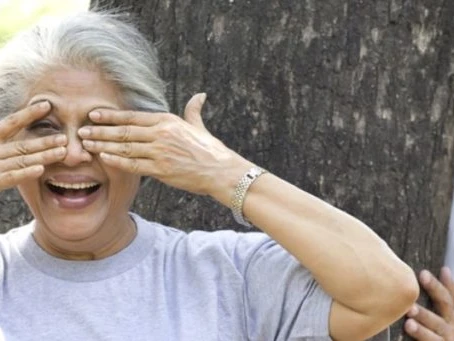Case Note of Mr Narayanan
A 70-year-old patient approached us for Physiotherapy with complaints of not being able to use the right side of her body following a vertebral dissection and left side stroke which he had suffered 1 months back.
Examination revealed constant pain in the paralyzed shoulder; he had no movement of his paralyzed arm and leg and completely depended on his family members for all his daily activities like dressing, moving in bed, grooming etc. He was bed bound.
Rehabilitation focused mainly on:
- 6 sessions per week, duration about 1 hour.
- Pain management for shoulder
- Training his bed mobility activities such as rolling to side lying, side lying to sitting
- Trunk control: sitting and righting within the base of support sideways, front and backwards.
- Balance and training to walk.
- Progression to stair climbing and descending
- Wall standing for 20mins
The treatment plan was modified as the patient improved. Regular follow-up visits were done for him and his progress was recorded at each interval. By the end of 10 weeks, he was able to move his arm without any pain and use it for feeding and bathing. With respect to his lower limb, he is now walking with no support and climb stairs with railing support. He also goes out for walks with his friends outside his house.
Weight bearing exercises helps fastest recovery of muscle power and balance.
Worldwide Statistics
According to the World Health Organization, 15 million people suffer stroke worldwide each year. Of these, 5 million die and another 5 million are permanently disabled.
High blood pressure contributes to more than 12.7 million strokes worldwide.

In developed countries, the incidence of stroke is declining, largely due to efforts to lower blood pressure and reduce smoking. However, the overall rate of stroke remains high in geriatric age group.
Nearly three-quarters of all strokes occur in elders over the age of 65. The risk of having a stroke more than doubles each decade after the age of 55. Strokes can and do occur at ANY age. Nearly one fourth of strokes occur in people under the age of 65.
What Happens After a Stroke?

A stroke occurs when blood flow to the brain is compromised due to a blockage in the artery (an ischemic stroke). Strokes are also caused from blood leaking into the brain from a ruptured artery (a haemorrhagic stroke). Blood carries oxygen to the brain to help all portions of the brain function properly. When anything disrupts the oxygen levels in the brain (causing it to decline to dangerous levels), brain cells die off and portions of the brain cease to work. This causes a whole host of symptoms, which include:
- Paralysis (usually on the affected side of the body)
- Numbness in the extremities (hands, feet, arms or legs)
- Difficulty speaking and closing the mouth fully
- Difficulty swallowing and drinking
- Dizziness
- Difficulty breathing
- Loss of balance and coordination
- Fainting or going unconscious
- A sudden excruciating headache

Some complications are expected after having a stroke. These complications can be permanent, but they usually improve after receiving quick treatment. Most commonly, a stroke patient will retain an uneven appearance to their face due to the loss of muscle function on one side. They may also have trouble lifting, standing or picking up objects due to muscle weakness. While emergency treatment is aimed at removing the blockage or stopping the bleeding, long-term treatment will be required to prevent and improve complications.
Physiotherapy uses
The first stages of post-emergency treatment include healthy eating and quitting health-harming habits, like smoking and excessive drinking. According to the National Heart, Lung and Blood Institute, exercise also helps prevent and control many stroke complications. Exercising after a stroke can be difficult due to the loss of muscle function (from brain damage), loss of balance and the resulting muscle weakness. This is when stroke patients are often referred to physiotherapists. The brain cannot regenerate any cells lost during the stroke, but physiotherapy can help the brain reorganize existing cells to compensate for the loss (neuroplasticity), according to the Stroke Association. This requires a full physical recovery plan that includes:
o Exercise
o Massage
o Learning new skills
o Electrical treatment
o Manipulation

The amount of time an elder and their physiotherapist spends on each part of the recovery plan is determined by the doctor and therapist. They will devise a plan that helps the patient reach new goals and retain normalcy in a safe and controlled environment.
General Treatment Structure
Physical therapy is often conducted in a medical clinic that looks a lot like a mini-gym; with weights, treadmills, balance balls, mats and special medical equipment used to encourage movement. If the elder is unavailable to visit the clinic, the physiotherapist visits the elder at home to provide therapy. The physiotherapist will work with the patient one-on-one and give instructions on how to do each assigned activity. As a general guideline, physical therapy is given 45 minutes per day alongside any additional treatments that may be needed. The initial goal is to get the patient moving. Afterwards, the physiotherapist helps the patient regain strength, coordination and function.
It is important to work with, and follow the regime prescribed by a physiotherapist. Independent workouts in a gym may exacerbate existing symptoms and worsen complications. It could also increase the risk of further injury.
The treatment plan for the young and elderly patients has vast differences. We cannot give same exercises for an elderly patient and young patient during the stroke rehabilitation.
While providing stroke rehabilitation to an elder, a geriatric physiotherapist will look into the elder’s complete health. He often then discuss the health issues with the geriatrician and proposes a care plan in concurrence with the geriatric team.
A young patient can easily do all the exercises and its repetition but an elderly patient will get tired too easily. Each and every elder have different type of perception and mindset and tolerance. Each physiotherapy plan is customised to suit the health status of the elder.
About the Author: Mr Muhunthan Mazinold, is the Chief Physiotherapist of Dr Rahul’s Elder Care. He is a post graduate in Orthopedics Rehabilitation( MPT- Orthopedics). He specializes in complex rehabilitation in elders with movement disorders, dementia and multiple comorbid conditions. He has presented on pain management in national and international seminars. His research interest involves movement disorders and pain management
“We are excited to announce that we have expanded our geriatric care clinic to Kochi, also known as Cochin, in Kerala. Our experienced team of doctors and nurses is dedicated to providing high-quality medical care and compassionate support to seniors and their families. We offer a range of services, including doctor consultation, doctor consultation at home, and nursing. Whether you need medical attention for yourself or your loved ones, we are here to help. Contact us today to schedule an appointment and experience the difference at Dr. Rahul’s Elder Care.”



